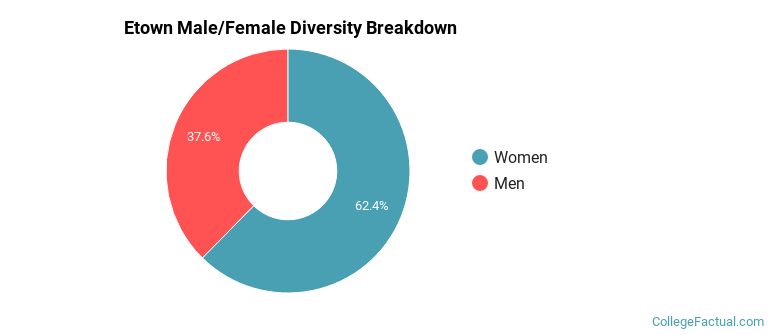 by our College Data Analytics Team
by our College Data Analytics TeamEtown total enrollment is approximately 1,881 students. 1,486 are undergraduates and 74 are graduate students.
Male/Female Breakdown of Undergraduates
The full-time Etown undergraduate population is made up of 60% women, and 40% men.

For the gender breakdown for all students, go here.
Etown Racial/Ethnic Breakdown of Undergraduates

| Race/Ethnicity | Number |
|---|---|
| White | 1,280 |
| Hispanic | 71 |
| Asian | 39 |
| Black or African American | 34 |
| Unknown | 25 |
| Multi-Ethnic | 22 |
| International | 14 |
| Native Hawaiian or Pacific Islander | 1 |
See racial/ethnic breakdown for all students.
Male/Female Breakdown of Graduate Students
About 91% of full-time grad students are women, and 9% men.

For the gender breakdown for all students, go here.
Etown Racial-Ethnic Breakdown of Graduate Students

| Race/Ethnicity | Number |
|---|---|
| White | 66 |
| Hispanic | 4 |
| Asian | 2 |
| Black or African American | 2 |
| Native Hawaiian or Pacific Islander | 0 |
| International | 0 |
| Multi-Ethnic | 0 |
| Unknown | 0 |
See racial/ethnic breakdown for all students.

| Race/Ethnicity | Number |
|---|---|
| White | 1,611 |
| Hispanic | 95 |
| Asian | 52 |
| Black or African American | 50 |
| Unknown | 33 |
| Multi-Ethnic | 24 |
| International | 15 |
| Native Hawaiian or Pacific Islander | 1 |

There are approximately 1,183 female students and 698 male students at Etown.
Etown ranks 814 out of 2,183 when it comes to geographic diversity.
36.03% of Etown students come from out of state, and 2.03% come from out of the country.

The undergraduate student body is split among 20 states (may include Washington D.C.). Click on the map for more detail.

| State | Amount |
|---|---|
| Pennsylvania | 277 |
| Maryland | 52 |
| New Jersey | 51 |
| New York | 9 |
| Virginia | 5 |
Students from 29 countries are represented at this school, with the majority of the international students coming from China, Vietnam, and Brazil.
Learn more about international students at Etown.
A traditional college student is defined as being between the ages of 18-21. At Etown, 85.07% of students fall into that category, compared to the national average of 60%.

| Student Age Group | Amount |
|---|---|
| 20-21 | 783 |
| 18-19 | 693 |
| 22-24 | 225 |
| 25-29 | 15 |
| 35 and over | 4 |
| 30-34 | 3 |
| Under 18 | 0 |
Footnotes
*The racial-ethnic minorities count is calculated by taking the total number of students and subtracting white students, international students, and students whose race/ethnicity was unknown. This number is then divided by the total number of students at the school to obtain the racial-ethnic minorities percentage.
References
Department of Homeland Security Citizenship and Immigration Services
Read College Factual's Diversity Ranking Methodology.